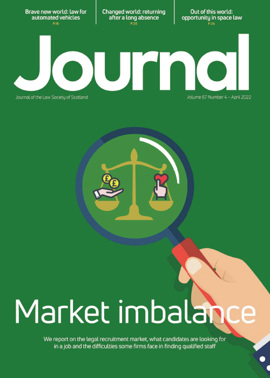Return to work: getting it right

To say that the world of work has been subject to change in the past two years would be an understatement. Offices that previously never had to consider remote working had to do so overnight, and two years on, the majority of legal workplaces are operating on a hybrid model.
But what has remained a constant is the fact that employees have “returned” to work after periods of leave throughout these two years. Parental, compassionate and sick leave have all continued regardless of the global pandemic. What has been challenging for employers and employees alike, is managing the return to work when employees are not returning to the traditional place of work that they once were. Here we look at how an employer can support an employee returning to work, to a workplace that is possibly very different from the way it used to be.
During the absence period
A smooth return to work, regardless of the reason for the absence, starts with how the employee is treated during their time off. While on many occasions it will be entirely appropriate not to see or hear from the employee for the majority of the period of absence (for example during maternity leave), at other times it will be important to ensure that lines of communication are open and supportive measures put in place where appropriate.
If there has been a long absence, or the employee has an ongoing health condition, it’s a good idea for the employer and employee to meet, to make sure the employee is ready to return to work and talk about any work updates or changes that happened while they were off. This will enable them to feel more connected to the workplace and less anxious about a return to somewhere they haven’t been for many months. Furthermore, it’s important to take into consideration any recommendations from the employee’s doctor or occupational health professional, to ensure that a return is consistent with external advice, including on phased returns, or reasonable adjustments.
If an employee has a disability, by law their employer must make “reasonable adjustments” if needed to help them return to work. Reasonable adjustments could include making changes to the employee’s desk or workspace, working hours or duties.
Where an employee has been off for parental leave (maternity, paternity, adoption, shared parental leave for example), their return to work will (hopefully) have been discussed ahead of time. If an employee wishes to return to work before the end of her statutory maternity leave, she must give her employer at least eight weeks' notice of her date of return. Staff may have also had some keeping-in-touch days (“KIT days”), which will have given them the opportunity to be kept up to date with what has been going on while they have been away. Using KIT days appropriately is a great way of ensuring that a return to work is planned well, with both parties understanding what is expected of them.
It’s important to remember that when supporting employees returning to work, particularly from parental leave, their priorities will have shifted and they will need some time to adjust to managing work life alongside family life (I say this having just returned from maternity leave myself!). Supporting your employees with a newborn and young family during working life can reap dividends in years to come. Don’t risk losing good talent because your company didn’t support them.
Benefits of a supportive return
While it might be easy to dismiss a return to work as being “just another day at work”, this is not the case, particularly for the returning staff member. Among the benefits of getting this right is that employers will likely see greater employee engagement and all the positives this brings in terms of reduced staff turnover, reduced recruitment and retraining costs, and increased productivity.
Having a proper return to work plan in place, be it a phased return or other approach, can enable an employee to adjust more easily. An effective return to work process can prevent repeat absences and avoid grievances being raised due to lack of communication, or lack of support for the employee in their role.
Risks of getting it wrong
Failing to plan effectively for an employee’s return to work can bring risks to an employer that, as outlined above, could be otherwise avoided. Where an employee feels there has been an unsupportive return to the workplace, and they are being treated differently as a result of their absence, they may feel they have no option but to raise a grievance, or resign from their position.
Flexible working requests
Alongside a return to work often comes a flexible working request. An employee has a statutory right to make a flexible working request if they have at least 26 weeks’ service. Their request can relate to hours of work, the times they work and where they work.
Recent research found that Employment Tribunal claims relating to flexible working requests rose 52% from 2019-20 to 2020-21. It was suggested that this was likely to be driven by employees fighting attempts by their employers to have them come back to the office. What we have seen in the past two years is how effectively employees can work from home, and how this can benefit them, the employer and the client. It is anticipated that there will be a further increase in these claims in the coming year.
Hybrid working
The benefit of hybrid working has been huge for employees (and employers), and many employees will see this as an essential when considering where they work. A flexible working request by a returning employee may include a specific request for hybrid working (if this is not already in place), and agreeing to this can ensure a smooth transition back to the workplace.
However, hybrid working can also prove challenging for an employee returning from a period of leave, and employers will want to ensure that someone working at home is not “adrift” when it comes to their work life. Having regular Teams or Zoom calls can assist in the employee feeling part of the team and, in turn, provide for a smooth return to work.
Returns to work can be challenging if they are not managed correctly, but even in the difficult times of the pandemic, this can be a positive and engaging process for staff and employers if careful consideration is given to it.
P&O: A ferry bad approach to redundancy
A note on how redundancy situations should be handled
In the UK, an employee is dismissed for redundancy if:
- the employer has ceased, or intends to cease, continuing the business, or
- the requirement for employees to perform work of a specific type, or to conduct it at the location in which they are employed, has ceased or diminished, or is expected to do so.
If there’s a genuine redundancy, employers must follow correct procedure and make redundancy and notice period payments.
P&O hasn’t ceased its business, so is presumably relying on the second ground above. However, it is difficult to square this with the fact that services will still run, but with agency staff to carry these out instead.
So what should have happened? To begin with, P&O should have looked at how many employees it was proposing to make redundant at “any one establishment”, with “establishment” likely being each port where crew were based. Employers are required to consult individual employees and give them reasonable warning of impending redundancy.
Although there’s no minimum statutory timescale when fewer than 20 employees are made redundant, the consultation must be meaningful and may also be covered by contractual terms or policies. An employee is entitled to be accompanied at all individual consultation meetings by a trade union representative or colleague.
If 20 or more employees at one establishment are to be made redundant, collective consultations with recognised trade unions or elected representatives must take place:
- at least 30 days before the notification of redundancies for dismissals of 20-99 employees;
- at least 45 days before notification for dismissals of 100 or more.
Collective consultations must be completed before dismissal notices are issued. If there are no recognised trade unions or employee representatives, the employer must facilitate an election, by the employees, of representatives for the consultation. The law requires “meaningful” consultation – it’s not enough only to inform employees of a decision that has already been made. Failing collective consultation, the maximum extra compensation payable (a “protective award”) is 90 days’ pay per employee.
The employer would also have to lodge a form with the Government advising of the number of redundancies proposed. That enables the Government to explore whether there is anything it can do to change the situation, or help those being made redundant. Failure to take this step would be a criminal offence, therefore it is assumed that the Government was aware of the 800 P&O dismissals.
If it had followed correct procedure, P&O would be paying those selected for redundancy their statutory, or company redundancy payments, as well as a payment in lieu of notice, on the basis that staff were not given notice. It might also have agreed enhancements with employees and entered into settlement agreements to terminate their employment.
This is a story that continues to develop, and with reports that some of the dismissed employees have agreed settlement agreements with their former employer, as well as pressure from the Government to rehire dismissed staff, it is clear that P&O and its legal and PR teams will be dealing with the reputational fallout that their mismanagement of this situation has caused.
Perspectives
Features
Briefings
- Criminal court: Thom bar still applies
- Licensing: tighter rules for the pet trade
- Insolvency: Transition from the COVID measures
- Tax: What did the Spring Statement bring?
- Immigration: Providing a home for Ukrainians
- Scottish Solicitors' Discipline Tribunal
- Property: RCI – what does it involve?
- In-house: Looking for a star







